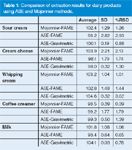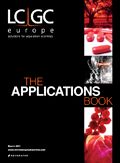Base Hydrolysis and Accelerated Solvent Extraction (ASE): Determination of Total Fat from Dairy Products
Dionex Application note
Brett Murphy, Jennifer Peterson, Bruce Richter, David Knowles and Richard Carlson, Dionex Corporation, Sunnyvale, California, USA.
This application note demonstrates the extraction of sour cream, cream cheese, coffee creamer, heavy whipping cream and low fat milk using an ASE 350 Accelerated Solvent Extractor technique developed by Dionex and compares results to the traditional Mojonnier technique. The resulting extracts were derivatized and analysed by GC–MS according to AOAC Official Method 996.06.
Previously, it has been shown that ASE instruments can successfully extract fat from a number of different food matrices after an acidic hydrolysis treatment step.1 This application note demonstrates that ASE can also be used to extract dairy products following base hydrolysis. Current methods for determining fat in dairy products are adequate, but have several drawbacks: they are very labour intensive and time consuming, and they consume large amounts of expensive solvents. Dairy products present a set of complex matrices. Pretreatment steps are required to denature the casein, allowing greater exposure of the fat to the extraction solvent. For example, a cheese sample must be treated in a multiple-step process even before the solvent extraction can be carried out. The entire manual extraction process usually requires 2–3 h and more than 100 mL of solvent per sample (AOAC Official Method 933.05). Although standard fat extraction methods — such as the Roese-Gottlieb, Gerber, Babcock and Mojonnier methods — give satisfactory results, they are time consuming and labour intensive.

Table 1: Comparison of extraction results for dairy products using ASE and Mojonnier methods.
Experimental Conditions
Sample Preparation:
Dairy samples were prepared by first performing a base hydrolysis according to AOAC Official Method 996.06 section G. The sample mixture was then mixed with 22 g of ASE Prep CR H+ and 12 g of ground ASE Prep DE. This sample mixture was then added to a 100 mL Dionium extraction cell containing an additional 5 g ASE Prep CR H+. The extraction cell was placed onto the ASE instrument and extracted using the following method:
ASE Conditions:
Cell size: 100 mL
Cell type: Dionium
Pressure: 1500 psi
Temperature: 100 °C
Solvent: Hexane
Static time: 5 min
Static cycles: 3
Flush: 60%
Purge: 150 s
Results
The extracts were evaporated to dryness for gravimetric fat determination and the remaining fat was esterified for FAME analysis using AOAC Official Method 996.06 section G and were analysed using GC–MS.
Conclusions
Combined with base hydrolysis, ASE yields equivalent results for determination of lipids from dairy products, when compared to more time-consuming extraction techniques such as the Mojonnier method.
Reference
1. Dionex Corporation. Extraction of Total Fat from Food Samples After Acid Hydrolysis Using Accelerated Solvent Extraction (ASE) with GC–MS Analysis, Application Note 361 (LPN 2008, March 2008).

Dionex Corporation
1228 Titan Way, PO Box 3603, Sunnyvale, California 94088, USA
tel. +1 408 737 0700 fax +1 408 730 9403
Website: www.dionex.com

Analytical Challenges in Measuring Migration from Food Contact Materials
November 2nd 2015Food contact materials contain low molecular weight additives and processing aids which can migrate into foods leading to trace levels of contamination. Food safety is ensured through regulations, comprising compositional controls and migration limits, which present a significant analytical challenge to the food industry to ensure compliance and demonstrate due diligence. Of the various analytical approaches, LC-MS/MS has proved to be an essential tool in monitoring migration of target compounds into foods, and more sophisticated approaches such as LC-high resolution MS (Orbitrap) are being increasingly used for untargeted analysis to monitor non-intentionally added substances. This podcast will provide an overview to this area, illustrated with various applications showing current approaches being employed.

















